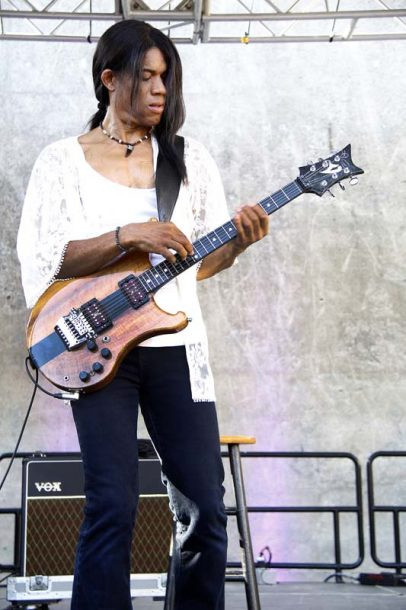Stanley Jordan is a name synonymous with innovation and virtuosity in the world of guitar. Rising to prominence in the mid-1980s, Jordan didn’t just play the guitar; he reinvented how it could be played. Emulating the piano, his primary instrument, he pioneered a groundbreaking “touch style” or “tapping” technique. This method, involving both hands independently fretting notes on the guitar neck, unlocked unprecedented contrapuntal possibilities and established a new benchmark for solo guitar performance. His unique approach has not only captivated audiences worldwide but has also profoundly influenced contemporary guitar playing, solidifying Stanley Jordan’s place as a true icon of the instrument.
Stanley Jordan’s innovative approach extends beyond his solo work. He frequently performs on both guitar and piano simultaneously, showcasing his multifaceted musical talent. His collaborations are equally diverse, ranging from his own projects to performances with groups like bassist Charnett Moffett’s NeTTwork. Known for his constant evolution, Jordan’s musical journey continues with upcoming projects, including a highly anticipated follow-up to his Duets album with Kevin Eubanks, slated for release on Mack Avenue. Beyond the jazz world, Stanley Jordan has also found a welcoming audience in the jam-band scene, sharing the stage with acts like the Dave Matthews Band, Umphrey’s McGee, and Phil Lesh and Friends, further demonstrating his genre-bending appeal and broad musical reach.
 Stanley Jordan at the 2015 Detroit Jazz Festival. Photo courtesy of the festival
Stanley Jordan at the 2015 Detroit Jazz Festival. Photo courtesy of the festival
His journey is not just confined to music; Jordan is also active in software development and music therapy, reflecting his diverse interests and commitment to making a difference beyond the stage. Adding another layer to his already fascinating persona, Jordan has embraced an androgynous “femme” appearance in recent years, a personal evolution that he has begun to openly discuss, linking it intrinsically to his artistic expression and multifaceted identity. Currently residing in Sedona, Arizona, the ever-touring Jordan remains a global presence, constantly engaging with diverse audiences and musical landscapes, as was evident during a recent visit to New York where he sat in with The Roots on The Tonight Show Starring Jimmy Fallon. This appearance provided an opportunity for reflection on his personal journey and artistic philosophy, revealing the depth and complexity that underpins Stanley Jordan’s remarkable career and unique approach to music.
The Genesis of a Unique Guitar Style
Stanley Jordan’s groundbreaking “touch style,” sometimes referred to as “tapping,” revolutionized guitar playing by drawing inspiration from the piano. Unlike conventional guitar techniques that primarily use one hand for fretting and the other for strumming or picking, Jordan’s method involves both hands independently striking and fretting the strings directly on the fretboard. This innovation allows him to play melody, chords, and bass lines simultaneously on the guitar, achieving a polyphonic texture akin to a pianist playing multiple voices at once. This technique opened up entirely new sonic possibilities for the guitar, transforming it into an instrument capable of much richer and more complex solo performances.
Jordan’s journey to developing this style began in his early musical explorations. As a child, the piano was his first instrument, and this early influence is palpable in his guitar playing. He started experimenting with the touch style in the mid-1970s, around 1976 or 1977, seeking to emulate the independence and polyphony he experienced at the piano. This period coincided with a broader musical movement emphasizing improvisation and freedom, not only in rock but also in jazz. Jordan cites early influences from artists like Herbie Hancock, George Benson, and Stanley Turrentine, as well as seeing Prince Lasha and Charles Moffett’s band, which featured a young Charnett Moffett. These experiences in the 1970s, emphasizing musical freedom and improvisation, profoundly shaped his artistic psyche and fueled his desire to break conventional boundaries with the guitar.
Embracing Freedom: From Jam Bands to Personal Expression
Stanley Jordan’s affinity for the jam band scene is a natural extension of his long-held belief in musical freedom and improvisation. He recalls feeling comfortable in this scene even before it was formally recognized as such, reminiscing about playing rock music with friends in the 1970s. The core ethos of the jam band culture – music as a spontaneous event, embracing improvisation and “going with the flow” – resonated deeply with Jordan’s artistic philosophy, which he had already been developing through his jazz influences. This connection to improvisation and live musical experiences has made his collaborations with bands like Dave Matthews Band, Umphrey’s McGee, and Phil Lesh and Friends feel like a natural fit, allowing him to explore the boundaries of his touch style within diverse musical contexts.
This pursuit of freedom extends beyond genre and technique into personal expression. Jordan’s evolving personal style, including his androgynous “femme” look, is deeply intertwined with his artistic journey. He views art and life as mutually reinforcing, aiming to create beauty in both realms. For Jordan, art, especially jazz, is about being present in the moment, a concept he links to spiritual growth. However, early in his career, he encountered unspoken rules and limitations within the professional music world, even regarding his dress code. An anecdote about “Papa” Jo Jones advising him on wearing a suit highlighted these early pressures to conform. Yet, another experience, where a fan suggested he played better without a suit, underscored the conflict between external expectations and authentic self-expression.
Style as Artistic Extension
Jordan’s exploration of personal style became more deliberate around the time of his Cornucopia album in 1990. Hiring a stylist marked a conscious effort to explore the visual aspect of his artistry more freely. This exploration ranged from tailored suits to more contemporary looks, including leather pants, signaling a move away from rigid expectations and towards a more fluid representation of self. This journey towards embracing diverse self-expression culminated in his 2011 album Friends. For this project, Jordan intentionally used different styles of clothing to embody the varied emotional landscapes of the songs, finding the experience profoundly successful in connecting his visual presentation with his musical intentions.
For Stanley Jordan, authentic artistic expression necessitates dealing with the multifaceted nature of one’s identity. He identifies with a diverse range of archetypes – “hippie,” “homeboy,” “girly girl,” “Ivy League academic,” “tech geek,” and more – recognizing these as genuine facets of himself. This multifaceted identity extends to his musical background, rooted in classical music, rock, and jazz, all formative influences from a time of open musical exchange and cultural intermingling. This upbringing instilled in him the belief in music’s power to effect change, a core motivation behind his playing.
Addressing criticisms about his stylistic diversity, Jordan questions the pressure to conform to a single musical mold. He sees his refusal to be categorized as a strength, a manifestation of his courage to embrace all facets of himself. Overcoming the fear of judgment and consequence is an ongoing process, but one he believes is essential for authentic artistic expression and positive impact. He acknowledges the gradual societal shift towards greater acceptance of LGBTQ rights as creating a more open environment, and he feels he has contributed to this change in his own sphere. Referencing transgender activist Virginia Prince, Jordan emphasizes the power of truth and trusting that people will eventually confront and accept it.
While hesitant to adopt labels, Jordan ultimately identifies most comfortably with simply being “Stanley.” He points out the fluidity of names and gender, referencing President Obama’s mother also being named Stanley. A pivotal moment in his personal journey occurred around 2010 when, in a remote location, he was drawn to a dress shop. This experience led to a transformative moment of self-recognition when he tried on a floral brocade mini-dress, layered over jeans. This combination, blending feminine and masculine elements, provided him with a profound sense of wholeness and self-acceptance, realizing that his spirit transcends conventional gender boundaries. While comfortable in his current self-expression, Jordan remains open to future possibilities of personal evolution, viewing his journey as a personal renaissance, exploring the potential of his body and identity beyond societal norms.
His long-term relationship of over ten years has been a supportive anchor throughout this personal evolution. While acknowledging that all relationships require effort, Jordan expresses gratitude for his partner’s unwavering love and acceptance. This personal transformation has directly enriched his music. He feels a deepening of expressiveness and a more natural flow of ideas, attributing this to a more open heart and a commitment to expressing the full spectrum of his identity authentically. For Jordan, it is not about adhering to a single look or undergoing a radical transformation, but about the freedom to express the variations within himself, similar to anyone choosing clothes each day, but with a broader spectrum of expression necessary for his comfort and authenticity.
The Feminine Energy in Jazz and Beyond
Stanley Jordan observes a prevailing masculine energy within the jazz world, noting it is not just about male leadership but the prioritization of masculine traits. He feels jam sessions, often dominated by “testosterone overload,” can lack respect for the music itself, focusing more on ego and technical display than melody and nuance. He contrasts this with older jazz musicians who had a deeper “relationship with the music,” a quality he identifies as a more “feminine energy” that he feels has been diminished in contemporary jazz. While acknowledging the power of masculine energy, Jordan believes jazz has overemphasized it, leading to excessive instrumental showmanship at the expense of musicality and emotional depth.
He describes feminine energy in music as being “in relationship with the music,” allowing it to guide the performance. This approach values simplicity, beauty, and genuine emotional expression over mere technical complexity for its own sake. Jordan emphasizes that finding a personal balance between masculine and feminine energies has deepened his music, advocating for all musicians to explore and find their own equilibrium.
Despite negative reactions, including ignorant comments online, Jordan notes a surprising positive consequence of his evolving appearance. He observes that, presenting in a more “femme” style, he experiences less fear from mainstream society, a stark commentary on racial perceptions. He reflects on the constant, almost invisible, fear he experienced as a black man, which diminished as his appearance shifted. While occasional instances of mockery occur, Jordan emphasizes the overwhelming indifference of most people. Ultimately, he finds comfort and authenticity in his own skin, stating, “Yes, the difference is now I look happy,” underscoring the profound personal liberation and artistic fulfillment he has achieved through embracing his true self.
This journey of self-discovery and artistic innovation solidifies Stanley Jordan’s legacy not just as a technical virtuoso on the guitar, but as a pioneering artist who challenges conventions, embraces personal truth, and continuously redefines the boundaries of musical and self-expression.

